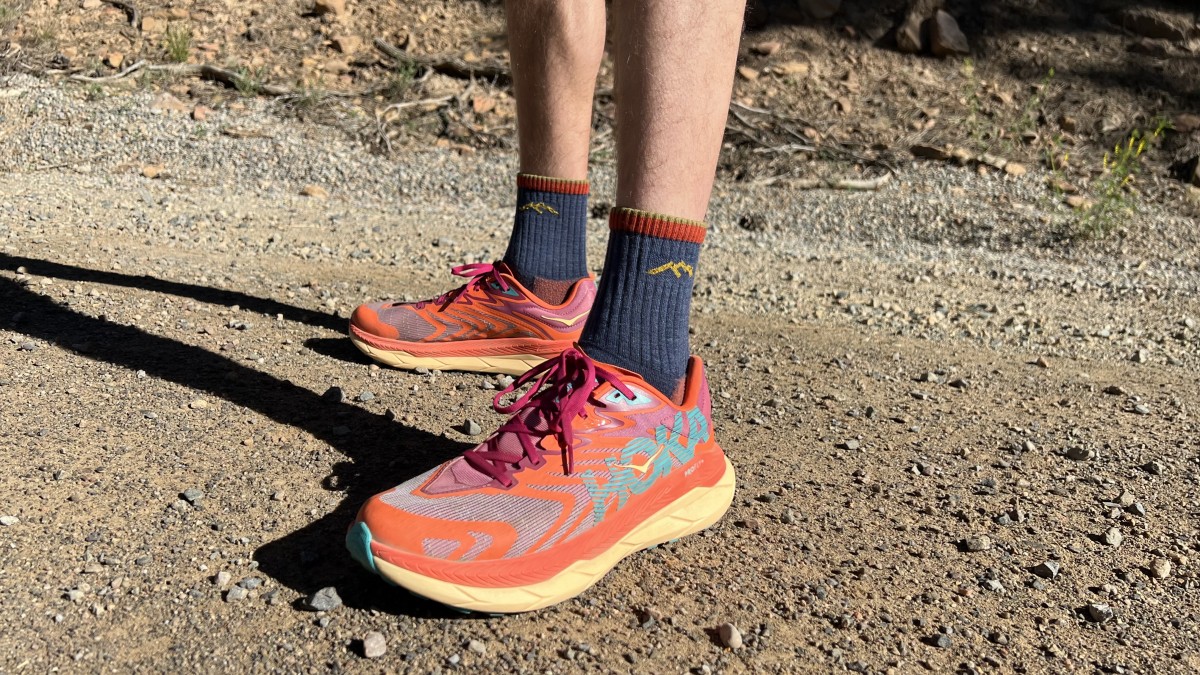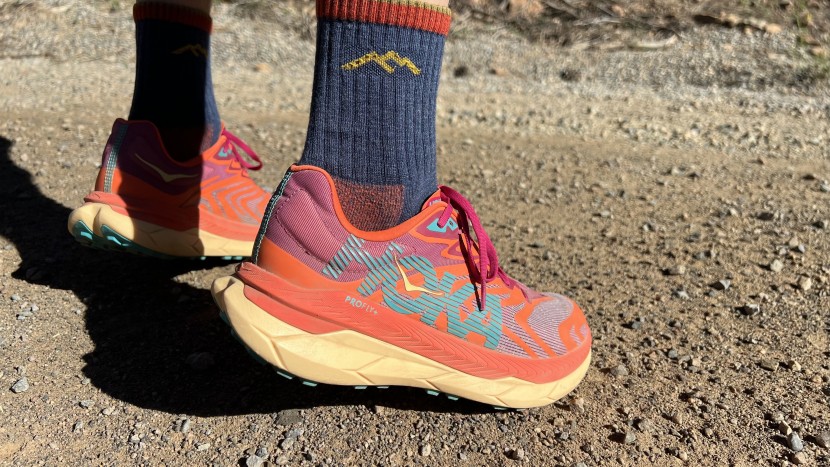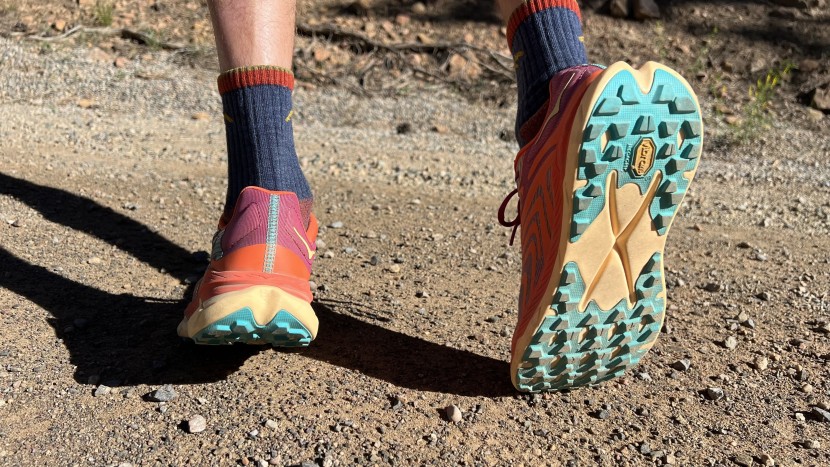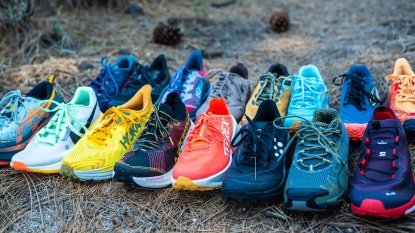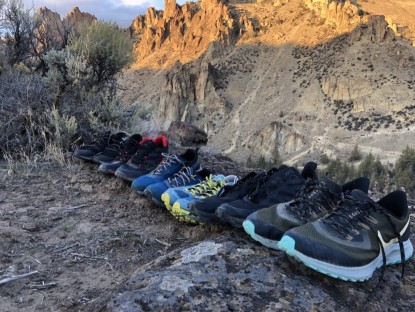Hoka Tecton X 2 Review

Our Verdict
Our Analysis and Test Results
The Hoka Tecton X 2 is one of the fastest shoes in our test lineup. The integrated carbon plate is excellent at transferring energy and propelling you forward. Crossover is a buzzword that's used often, but what actually is crossover terrain? Largely this shoe does everything you could want, but it is best on easy buffed trails and gravel roads. The smaller lugs also make it great for runs that start and end on roads. This shoe desires speed, and you must give it what it wants — otherwise, it will feel unruly and uneven. Given the price, it's clear that the Tecton X 2 is for experienced athletes and situations where time matters. If you often run on crossover surfaces and need to shave seconds, this could be the shoe for you.
Foot Protection
We measured the stack height of this iteration at 38 mm in the heel and 31 mm at the forefoot, giving a little more of a drop than Hoka claims (Hoka claims 5 mm, our measurements equal 7 mm). The drop felt adequate, especially given the stability — any higher, and we'd expect it to feel a little tippy. The Tecton X 2 stands out compared to other plush ultrarunners thanks to the construction in the midsole. The ProFly X midsole is dual-layered and slightly stiffer than single-layered Hoka designs, but it offers a great balance of responsiveness and protection. The dual carbon fiber plates that run along the edges of the shoe add to the firm ride. The Matryx-knit upper is ultralight, but the stiff rubber toe cap provides structure and protection.
The signature 'X' carbon midsole provides ample foot protection, so much so that you can rarely sense what's underneath your foot. This is fine for focused running, especially while racing, but it can make easy runs feel a bit more vague. That said, for rocky terrain and gravel roads, the bottoms of your feet should remain fatigue-free over a longer period of time, thanks to the added protection.
Traction
The Vibram Litebase used on the Tecton X 2 is ideal, given its desire to run on harder, dry surfaces. This gives the shoe ample grip when there is good surface contact. However, due to this firmness, the X 2 isn't as great in wet conditions or when traction is needed on uneven surfaces.
While the lugs are 4.0 mm tall, they don't offer a ton of purchase, and their uniformity continues to suggest that this shoe isn't made for the most technical terrain. We never had issues with the traction on the Tecton X 2, but its lack of traction on technical terrain is noticeable.
Buffed track and gravel roads are ideal when running in this shoe, and we found tempo runs to be a blast with moderate traction that showed little turnover resistance. We've had minimal signs of tread loss even after many miles, another benefit of hard rubber, which wears less rapidly.
Sensitivity
Given the high foot protection and larger stack of the X 2, it's no surprise that there is minimal trail sensitivity. This is largely an issue on technical terrain but can be quite nice on monotonous terrains like gravel roads and pavement. This makes the ride more uniform, allowing you to focus your efforts on turnover and energy transfer. The one downside of this is when you lose focus and run more relaxed. Due to the lack of sensitivity, it can be easier to be less precise with your footwork, leading to potential injury issues in your ankles if you aren't careful.
Our team of experienced runners didn't find any of this to be a dealbreaker, but it's worth mentioning to those who are on the fence with the model. If you haven't developed proper form or are just starting to get into running, we'd look for a model that is less progressive when it comes to fit and feel.
Stability
The wide, stiff platform and low drop of the X 2 contribute to the feeling of stability. This is more than adequate on flat terrain where the foot can be properly planted. On technical terrain, the higher stack is noticeable and can sometimes feel uneven. The split carbon fiber plate claims to assist with this increased feeling when under torque, but we could never tell that the carbon fiber plate underneath was split. While we appreciate the benefits of carbon fiber plates, they aren't ideal for everyday runs, in our opinion.
This high rigidity of the X 2 adds support to the ankles, knees, and hips without feeling overly supportive. This is thanks to the high level of cushioning and responsiveness that keeps the shoe feeling fast and agile. Some shoes that are overly supportive tend to be dull and slow-feeling, far from the case with this model. While this wouldn't be our top pick for technical terrain, we still think it is suitable on most types of trails. For users heading into the mountains and tackling a lot of off-camber landscapes, we'd look for something with less stack. Your experience level will determine the type of trail you can tackle, with more experienced runners being able to push into more technical terrain.
Comfort and Fit
This is one of the most comfortable uppers we've tested. The new Matryx material on this version is slimmer than the previous model, with the toebox being more pointed. Our previous complaints regarding this shoe really only revolved around the upper, and Hoka adapted the model perfectly. We wouldn't say the X 2 is any narrower, though, as the toebox seems to have gotten most of the redesign. The tongue is also excellent and offers minimal padding while being ultralight. We wish all uppers felt this good.
The ground feel and running comfort are great, too. Ample cushioning reduces any harshness created by the carbon plate. We found long-run comfort thanks to the compressive nature of this model, and the high foot protection continuously reduces foot impacts and fatigue. On the flip side, off-camber terrain doesn't feel great, given the lateral stiffness and users who want an easy run may feel like the X 2 doesn't relax. For the most comfort, we'd recommend keeping this shoe on buffed or less technical terrain. While it can tackle more advanced terrain, it will require constant focus; perhaps not an issue for race day, but for easy runs, this shoe can feel easily overbuilt.
Weight
At 9.64 ounces per shoe for a US men's size 10.5, this is one of the lightest shoes in our lineup, which is impressive, given the amount of tech. Hoka is known for its light cushioning, and the additional carbon insert doesn't add much over some of the similar models. We'd argue this is a blend of the Speedgoat and Torrent series. This weight allows for easy turnover and creates a lightness when moving uphill. The propulsion properties keep the Tecton X 2 feeling energized and lively. Some could find this model to be a bit overkill for easy runs as the shoe can tend to overpower. Often, light shoes require lots of input from the user to feel fast, but the Tecton requires significantly less ground input to still feel lively and agile. At this weight, all types of events are possible, from fast sprints to ultra distance.
Should You Buy the Hoka Tecton X 2?
If you're an advanced runner looking for speed, we'd recommend the Tecton X 2. While not ideal for everyone, there is no better-performing model for those who run focused on crossover terrain. For the most advanced runners, we'd even argue you can take this on rough terrain due to your ability to focus and be precise even when fatigued. For more moderately experienced runners, you will find this shoe right at home, ripping through town or out on the local trails. Over time we found the X 2 to become more comfortable, and we think it's a great addition to a quiver for tempo days.
What Other Trail Running Shoes Should You Consider?
The Tecton X 2 is an innovative carbon-fiber shoe that is relatively new to our lineup. The other plated shoe we've tested is the Salomon Pulsar Trail Pro 2, which didn't score as highly but is worth checking out. If you love Hoka and prefer long distances, our recommendation is the Torrent 3. It's more versatile than the Tecton if you crave varied terrain, and it's also much cheaper. The Brooks Catamount 3 is also a great comparable option, giving a lighter shoe for a lower price tag.


